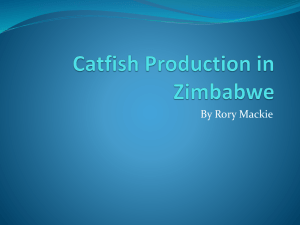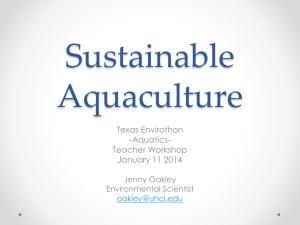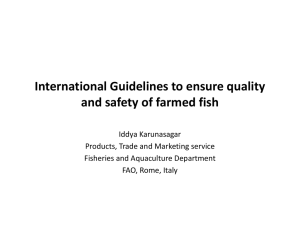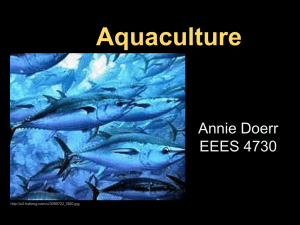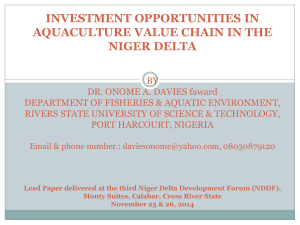The History of Aquaculture - Montgomery County Schools
advertisement
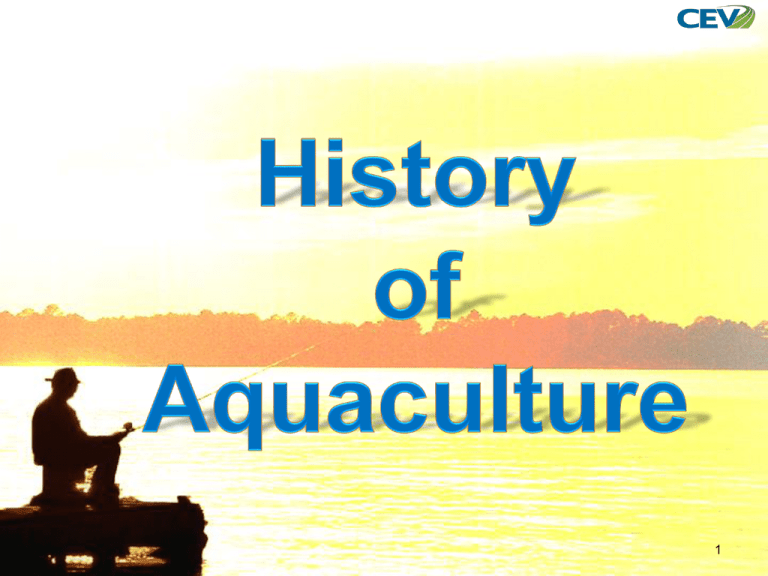
1 1. To describe aquaculture and understand its importance. 2. To examine the history of aquaculture and observe its present state. 3. To contrast aquaculture and fishing. 2 • Is the act of raising and harvesting fresh- and saltwater plants and animals • Incorporates raising fish and shellfish under controlled conditions for distribution and consumption • Includes raising tropical fish for aquariums 3 • Was when aquaculture emerged in China – noticed fish were often washed into ponds by monsoon floods – inspired idea of “stocking” ponds to provide families with food – rice growers also noticed fish in the rice fields and began practicing polyculture Polyculture – the raising of more than one species of plant or animal at the same time in the same place 4 • Was the year when Fan Lai wrote “The Classic of Fish Culture” – earliest detailed study of fish culture – describes the structure and function of ponds which house and promote propagation of carp Propagate – to cause an organism to multiply by any process of natural reproduction 5 • Is considered the “Golden Age” of common carp culture – Chinese continued to cultivate carp and spread the practice to neighboring countries – achieved progress in techniques of culture as well as recorded culture systems • Is the time in which southern Asia began describing the use of reservoirs to hold fish 6 • Accounts for the rule of the Tang Dynasty in China, which prohibited the cultivation of carp – found other species of fish to culture for their food and overall livelihood – discovered polyculture of fish in the same pond compliment each other by eating different types of food and staying in different areas 7 • Is the period when fry collection and dispersal in natural waters became highly developed • Was the era in India in which Namasollasa presented a publication concerning the fattening of fish in reservoirs • Is the time in which Chow Mit publishes “Kwei Sin Chek Shik” which describes fish transportation in bamboo baskets Fry – the young of fish 8 • Is when works concerning the complete aquaculture process were described, including the following: – methods of raising fry to adults – structure of ponds – application of food – disease control 9 • Is the first time brakish water aquaculture was used in Indonesia • Is the period in which the “Complete Book of Agriculture” was published in China, including information on pond cultivation Brakish Water – water which is saltier than fresh water but not as salty as seawater 10 • Is the period in which communication became readily available, allowing for the spread of information among countries • Allowed further fish culture methods to be developed, including the following: – fry production – seasonal occurrences of fry – transportation of fry 11 • Consisted primarily of fish culture • Includes Cornell University offering a curriculum for aquaculture in 1812 • Involves the transplantation and propagation of fish from their natural environments to new ones – allowed Americans to continue to purchase fish they were accustomed to overseas 12 • Included identifying and treating many diseases and fungi present among fish and their living environment • Consisted of standardizing common names of fish • Consisted of finding improved ways to transport fish and fry 13 • Universities began to develop aquaculture courses • Public interest in fishing rose, leading to the production of the baitfish industry • New methods for fish transport were utilized, including the airplane 14 • The Warmwater Training School at the National Fish Hatchery was established in Marion, Alabama – provides training for federal hatchery managers • Feed costs were reduced after the first dependable dry pellet diet for trout was marketed • An estimated 1.6 million ponds existed in the United States by 1950 15 • The Peace Corps extended practicing aquaculture in developing countries • Research improved feeding practices, disease control and organism growth – led to production on a larger scale and industry expansion • The Sea Grant College Program granted federal funding to land grant colleges for aquaculture research in 1966 16 • Increase in catfish pond acreage from 400 in 1960 to 40,000 in 1970 • Research allowed for better farming techniques after finding specific traits can be improved in fish – allowed for better growth, feed conversion and efficiency • The Food and Agriculture Act of 1977 stated Congress designate aquaculture as a basic duty of the Department of Agriculture 17 • Aquatic bioengineering emerged • The National Aquaculture Act of 1980 allowed for the establishment of the National Aquaculture Development Plan • Harvest limitations on commercial fishing began being imposed Bioengineering – the application of engineering principles and techniques to problems in medicine and 18 biology • Production doubles from 1984 – 1994 • Many fishermen move from traditional fishing to aquaculture • Perception of aquaculture changes as more people see it as a branch of agriculture 19 • Total value of world aquaculture production in 2000 was reported as $56.5 billion • Aquaculture production in developing countries as well as food-deficit countries has been steadily growing since 1970 • Aquaculture production is growing more rapidly than all other food production categories 20 • Aquaculture production in the United States has continued to increase since the 1970’s • United States’ fish and shellfish exports have more than doubled since 1985 • United States’ total consumption and importation of fish and shellfish products have gradually increased 21 • Differences include: – aquaculture involves production and growth while fishing only involves the harvesting – fish in aquaculture are kept in a controlled environment while those caught in fishing are from the wild – cost efficiency as aquaculture yields a higher income than fishing 22 1. 500 B.C. – 500 A.D. is considered the ________ ________ of common carp culture. 2. Aquaculture began in ________. 3. ________ is the raising of more than one species of plant or animal at the same time in the same place. 23 4. ________ is when you cause an organism to multiply by any process of natural reproduction. 5. ________ offered an aquaculture curriculum. 24 6. Aquaculture emerged between 1000 and 2000 B.C. a. true b. false 7. Total value of world aquaculture production in 2000 was reported as $56.5 billion. a. true b. false 25 8. The Sea Grant College Program granted federal funding to land grant colleges for aquaculture research in 1984. a. true b. false 9. Brakish water is water which is saltier than fresh water, but not as salty as seawater. a. true b. false 26 10. The Food and Agriculture Act of 1977 allowed for the establishment of the National Aquaculture Development Plan. a. true b. false 27 • A Brief History of Aquaculture www.aquaculturecenter.com • History of Aquaculture www7.taosnet.com • History of Aquaculture www.fao.org • Aquaculture Today www.northernaquafarms.com • History, Status, and Future of Aquaculture in the United States www.aces.edu • Aquaculture www.aphis.usda.gov 28
